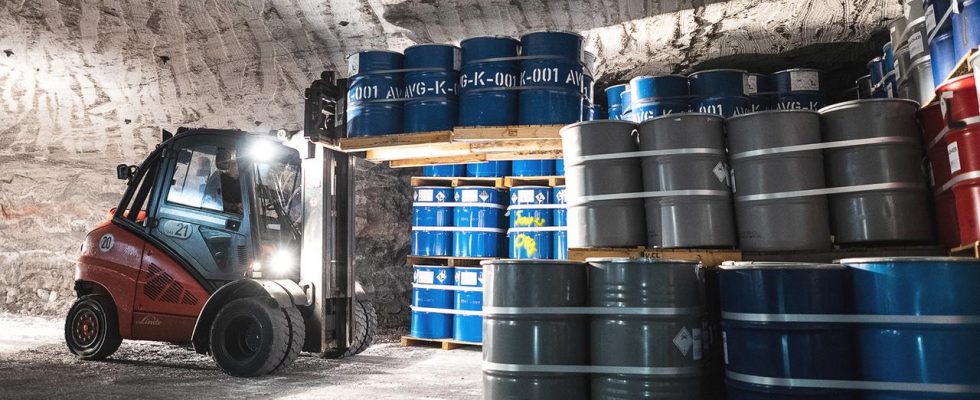In the middle
Dangerous poison lies in barrels 720 meters below ground: Hazardous waste is stored in the old mine in Herfa-Neurode in eastern Hesse. Length of stay: at least 10,000 years. A site visit.
Visiting the old mine in Herfa-Neurode in the far east of Hesse. Potassium salt used to be mined here. Today, class 4 toxic waste is stored in the tunnel system, i.e. waste that requires special monitoring. To get there you have to descend 650 meters.
The manager of the underground disposal site, Arnd Schneider, takes a sober look at his working environment: “We’re not talking about the most toxic or dangerous place, we’re talking about hazardous waste. Of course, you have to have respect for it, when handling it and when storing it. It’s down there completely different conditions than above ground.”
Geological structure provides protection
The journey down takes just under a minute, while the elevator travels at 35 km/h. The landfill belongs to the mining group K+S, one of the largest in the world. Arnd Schneider has been a miner all his professional life, he has been responsible for the warehouse for seven years. Barrels with roofing felt containing asbestos are just being delivered. A company paid around 300 euros per barrel for the hazardous waste to be stored here.
The special geological structure of the region offers the basic requirement: absolute dryness. “Above us there is still 100 meters of rock salt, then there is a layer of clay that covers the entire salt deposit and ensures that no groundwater can seep in,” explains Schneider.
Arnd Schneider manages the underground landfill in Herfa-Neurode.
“Completely normal day-to-day business”
The drums with the asbestos-containing roofing felt are transported by truck to their final storage location on roads that are almost ten meters wide. The air there tastes slightly salty, it’s warm, up to 28 degrees. The underground road network has a total length of more than 250 kilometers. The journey is over after ten minutes, the barrels are unloaded in chamber 160 with a forklift and stored. 720 meters below the surface of the earth.
The waste is stored separately according to substance groups for at least 10,000 years. There is rubbish containing cyanide, mercury and arsenic, among other things. The landfill in Herfa-Neurode does not accept everything: radioactive, explosive and gas-forming substances have to go elsewhere. It’s striking: in one of the most toxic places on earth, nobody wears high-security clothing. The landfill is certain that there is no danger from the waste, says manager Schneider. “Everything is checked in advance before the waste goes into the pit. Of course it can happen that something tears open and the contents trickle out, then the employees know how to behave. Everyone has personal protective equipment. That’s complete normal day-to-day business.”
Toxic waste transportation on underground roads in landfill.
In 2016 there was a fire in the toxic waste dump
A few hundred meters further, Schneider shows a full chamber. It is being walled up with bricks and sealed airtight.
A sensor measures whether gases are escaping. Such a sensor also reported the last major incident in 2016. At that time there was a fire in one of the chambers, the extinguishing work took several days. According to investigations by the public prosecutor’s office, no toxic fumes could escape. So the security system seems to be working.
A full chamber is sealed airtight.
doubt and fear
Klaus Reinhardt doubts that. The retired engineer lives just a few kilometers from the landfill and is afraid of further underground fires or even water ingress that could cause toxic waste to reach the surface: “Despite all the emergency plans, there is no 100% safety. Nothing has happened yet, but if it does what happens, then the damage is enormous and all help comes too late.”
In order to draw attention to the danger, he founded the citizens’ initiative “For a Werratal worth living in” in 2006. It now has around 200 members.
A citizens’ initiative wants to draw attention to dangers.
Security for 10,000 years?
60 percent of the stored toxic waste underground at a depth of 700 meters comes from Germany, 40 percent from other European countries. The archive of the landfill shows how large the facility is. Samples of all toxins are stored in vessels about the size of jam jars. There are more than 120,000 containers and 15 to 20 new ones are added every day.
At this rate, the landfill has room to accommodate another 60 years of toxic waste. Then it should be closed forever and no longer checked due to the special properties of the salt, explains Arnd Schneider: “In the long term, I’m talking about a period of several hundred years here, the flow properties of the salt will completely enclose the waste , so that subsequent monitoring is not necessary.” In theory, the toxic waste should then be stored isolated deep down in this way for all time.

